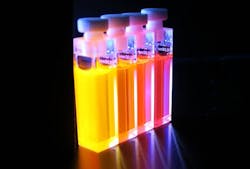Twisted conjugated polymers produce high-brightness fluorescent nanoparticles
A strategy to produce highly fluorescent nanoparticles through careful molecular design of conjugated polymers has been developed by King Abdullah University of Science and Technology (KAUST; Thuwal, Saudi Arabia) researchers, as described in a Nature article. Such tiny polymer-based particles could offer alternatives to conventional organic dyes and inorganic semiconductor quantum dots as fluorescent tags for medical imaging.
RELATED ARTICLE: Highly specific fluorescent nanoparticles could enable personalized medicine
Conjugated polymer-derived nanoparticles, called Pdots, are expected to transform several areas, including optoelectronics, bio-imaging, bio-sensing and nanomedicine, due to their intense fluorescence, high stability under exposure to light and low cytotoxicity. Their spectroscopic properties are tunable by tweaking the polymer structures. This makes it essential to consider their design at the molecular level.
Bio-imaging applications require nanoparticles small enough to be eliminated from the body and strongly emit light in the far-red to near-infrared range. However, current design and fabrication of Pdots have mostly relied on empirical approaches, hindering attempts to manufacture these ultrasmall nanoparticles.
To meet this challenge, Hubert Piwoński and associate professor Satoshi Habuchi came up with a systematic method that enhances the performance of Pdots. Habuchi explained that his team aimed to create Pdots of a smaller size and brighter fluorescence by using conjugated polymers, whose backbone of alternating single and multiple bonds enables so-called pi electrons to move freely throughout the structure.
For the first time, the researchers opted for twisted, instead of planar, conjugated polymers as building blocks to generate their Pdots. Existing Pdots usually exhibit lower fluorescence intensity than their precursors as result of complex inter- and intra-chain photophysical interactions within particles.
Preliminary results suggest that the newly synthesized nanoparticles were the smallest and brightest Pdots reported to date. "Therefore, we hypothesized that the twisted shape of the molecules is responsible for the very bright fluorescence due to the suppression of pi-pi interactions inside the particles," explained Habuchi.
The researchers validated their hypothesis by comprehensive photophysical and structural characterizations. "We are now trying to introduce functional groups into these Pdots for bioconjugation,” Habuchi continued. The team is also designing and fabricating near-infrared-emitting nanoparticles.
SOURCE: KAUST; https://discovery.kaust.edu.sa/en/article/346/the-brighter-side-of-twisted-polymers
About the Author

Gail Overton
Senior Editor (2004-2020)
Gail has more than 30 years of engineering, marketing, product management, and editorial experience in the photonics and optical communications industry. Before joining the staff at Laser Focus World in 2004, she held many product management and product marketing roles in the fiber-optics industry, most notably at Hughes (El Segundo, CA), GTE Labs (Waltham, MA), Corning (Corning, NY), Photon Kinetics (Beaverton, OR), and Newport Corporation (Irvine, CA). During her marketing career, Gail published articles in WDM Solutions and Sensors magazine and traveled internationally to conduct product and sales training. Gail received her BS degree in physics, with an emphasis in optics, from San Diego State University in San Diego, CA in May 1986.
